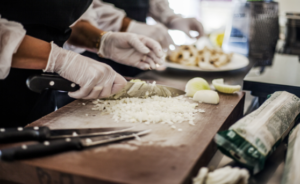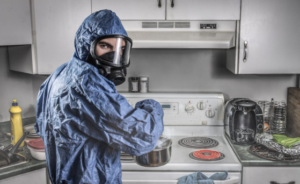Good and Safe Food Hygiene Practices in the Food Industry
Today’s article discusses the importance of maintaining food hygiene principles in the modern food industry. Ensuring that food is safe and secure for consumption is crucial. Companies that fail to follow food safety rules can face severe penalties for threatening consumers’ lives. To ensure food safety, following established food hygiene practices is essential.
In food outlets, the following procedures must be followed for proper food handling and hygiene:
- Use a new chopping board and knife for food preparation, and thoroughly clean all cutting surfaces and kitchen areas.
- Avoid storing hot food for more than two hours to prevent contamination and avoid fines.
- Keep the premises clean and free of dust and insects at all times.
- Ensure kitchen equipment and cutlery are always clean.
- Limit direct contact with food and maintain high standards of personal hygiene.
Food hygiene is vital in the food industry. Because neglecting it can lead to severe consequences, including health risks and legal penalties for both buyers and sellers. In conclusion, strict enforcement of food hygiene rules is essential to making society safer and reducing pollution.
Understanding Food Hygiene
Definition of Food Hygiene
Food hygiene involves the practices and conditions needed to keep food safe and clean from production to consumption. It includes steps to prevent contamination, control foodborne illnesses, and maintain food quality through proper handling, storage, preparation, and sanitation. These practices are essential for protecting public health and ensuring that food is safe to eat.
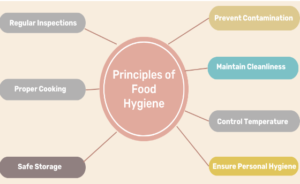
Key Principles of Food Hygiene
Prevent Contamination: Keep food safe from harmful bacteria, viruses, and chemicals by ensuring a clean environment and proper handling.
Maintain Cleanliness: Regularly clean and sanitize all surfaces, utensils, and equipment used in food preparation and storage.
Control Temperature: Store and cook food at the correct temperatures to prevent the growth of harmful microorganisms.
Ensure Personal Hygiene: Food handlers should practice good personal hygiene, including frequent handwashing and wearing clean clothing.
Safe Storage: Store food properly to prevent cross-contamination and spoilage. Keep raw and cooked foods separate.
Proper Cooking: Cook food thoroughly to kill any harmful bacteria or pathogens.
Regular Inspections: Conduct regular inspections and audits to ensure compliance with food hygiene standards and regulations.
Check out our Professional Food Hygiene and Safety course.
Personal Hygiene for Food Handlers
Importance of Personal Hygiene
Personal hygiene is crucial in the food industry because it directly impacts food safety and public health. By maintaining good personal hygiene, food handlers can prevent the spread of harmful bacteria, viruses, and other contaminants. This includes practices like regular handwashing, wearing clean uniforms, and avoiding direct contact with food when sick. Good personal hygiene reduces the risk of foodborne illnesses,, and helps maintain consumer trust and confidence in food establishments.
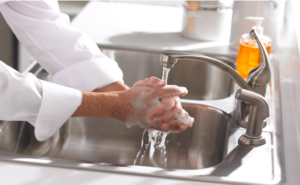
Handwashing Techniques
When to Wash Hands
Wash your hands before and after preparing food, after touching a baby or a sick person, after using the bathroom, after handling raw meat, and whenever they are dirty.
Steps for Correct Handwashing:
- Wash your hands with open water.
- Put soap on your hands.
- Scrub all areas of your hands thoroughly for at least 20 seconds.
- Rinse carefully.
- Dry with a clean towel or air dry.
Use of Personal Protective Equipment (PPE)
Gloves: Wear disposable gloves when handling ready-to-eat foods.
Hairnets and Caps: Cover hair to prevent hair from falling into Food.
Aprons and Uniforms: Wear clean aprons and uniforms to protect Food from contaminants.
Health and Wellness of Food Handlers
Reporting Illness: If any employee with Food Handler Cards is sick, please report it to your supervisor and do not work.
Regular Health Checks: Check food handlers regularly to see whether they are fit for work.
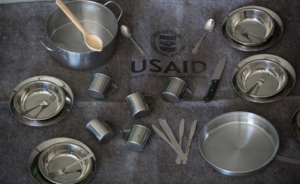
Kitchen and Equipment Hygiene
Cleaning and Sanitizing Procedures
Cleaning and sanitizing procedures in the food industry are vital for maintaining food safety and preventing contamination. Cleaning involves removing dirt, food residues, and other rubbish from surfaces and equipment using water and detergent. Sanitizing goes a step further by applying chemical or heat treatments to reduce the number of harmful microorganisms to safe levels.
Complete our Diploma in Food Hygiene Course.
Steps to Clean and Sanitise:
- Pre-Cleaning: Remove loose rubbish and rinse surfaces with water.
- Washing: Apply detergent and scrub to remove food particles, grease, and other residues.
- Rinsing: Rinse off the detergent and any remaining residues with clean water.
- Sanitizing: Apply a chemical sanitizer or use heat to reduce harmful microorganisms to safe levels. Follow manufacturer instructions for proper concentration and contact time.
- Final Rinse (if required): Rinse off any chemical residues from sanitizing.
- Air Drying: Allow surfaces and equipment to air dry completely to prevent recontamination.
Maintenance of Equipment
Periodic Checkup and Repair: Regularly inspect or repair equipment and maintain it in good working condition.
Correct Storage of Cleaning Equipment: Put cleaning equipment in a clean, dry location.
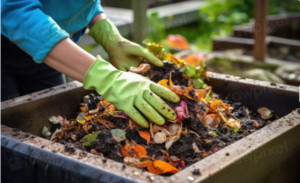
Waste Management
Proper Disposal of Food Waste: Food waste should be disposed of in a timely and sanitary manner to avoid pests and contamination.
Reusing, Recycling, and Reduction of Waste Policy: Promote recycling by creating a program and reducing waste by minimizing stock.
Food Storage and Temperature Control
Importance of Proper Food Storage
Proper food storage is essential for preventing foodborne illnesses and maintaining food quality. It keeps food at safe temperatures, reduces the risk of contamination, extends shelf life, and preserves nutritional value, ensuring that food remains safe and fresh from preparation to consumption.
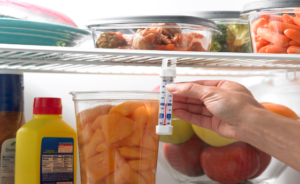
Temperature Control
Modified Atmosphere Packaging (MAP) is a technique used to lengthen the shelf life of foods. This technique is mostly used in bakery items like the heart of wheat loaves with crunchy crusts, butcher meats like pork cuts, and ocean fish like cod filets.
Safe Temperatures for Storing Perishable and Hot Foods: Keep foods that need to be refrigerated at 5°C (41°F) or lower. Make sure foods that should be hot stay above 60°C (140°F).
Use of Thermometers and Temperature Logs: Use a temperature log and thermometer to inspect food prepared and stored at a safe temperature.
Storage Practices
Defrost and Cooling: Defrost Food in the refrigerator, microwave, or under cold running water, and cool already-cooked Food rapidly.
First-In, First-Out (FIFO): Use older stock before newer stock to minimize waste and ensure food is used within its shelf life.
Separation: Keep raw and cooked foods separate to avoid cross-contamination. Store raw meat, poultry, and seafood below ready-to-eat foods in the refrigerator.
Proper Packaging: Use airtight and moisture-proof packaging to prevent spoilage and contamination. Ensure packaging is intact and labeled with expiration dates.
Clean Storage Areas: Regularly clean and sanitize storage areas to prevent contamination and pest infestations.
Check for Signs of Spoilage: Regularly inspect food for signs of spoilage, such as off smells, discoloration, or mold, and discard items that are no longer safe to consume.
Safe Food Handling Practices
Receiving and Inspecting Food Supplies
Inspection: Upon receipt of food supplies, check for signs of spoilage or contamination.
Rejection of Polluted or Degraded Goods: Reject Food items that do not conform to quality standards.
Food Preparation Techniques
Safe Cutting and Chopping Tips: Use different cutting boards for raw meat and other foods to prevent cross-contamination.
Correct Cooking Temperatures for Time: Cook foods thoroughly to kill pathogens.
Serving and Displaying Food
Serving Food Safely: Keep your hot and cold foods cold when service begins.
Using Clean and Safe Serving Utensils: Use clean and safe utensils when serving Food to avoid contamination.
Managing Allergens
Understanding Common Food Allergens
The most common food allergens include peanuts, tree nuts, milk, eggs, wheat, fish, soy, fish, and shellfish. All of these allergens require handling.
Preventing Cross-Contact: All surfaces and equipment exposed to allergens should be cleaned and sanitized post-treatment.
Allergen-Free Foods: Use separate utensils and equipment such as plates, knives, and cutting boards for allergen-free foods.
Labeling and Communication
Clearly Labeling Allergen Information: Clearly label foods containing allergens to inform customers.
Staff training on allergen management: Train staff to prevent cross-contamination, handle food safely, and clean kitchen surfaces effectively.
Record Keeping and Documentation
Importance of Accurate record-keeping
Accurate record-keeping in the food industry is essential for ensuring food safety and compliance with regulations. It helps track inventory, monitor food safety practices, and document any issues or incidents. Proper records support traceability in case of recalls, improve quality control, and provide valuable data for audits and inspections.
Types of Records to Maintain
Cleaning Schedules: Document cleaning schedules to ensure you regularly clean and sanitize.
Temperature Logs: Maintain temperature logs to track and ensure proper storage and cooking temperatures.
Health and Safety Inspections: Document health and safety inspections to track compliance.
Compliance with Food Safety Regulations
Meeting Local and International Standards: Ensure compliance with local and international food safety standards.
Preparing for a Food Safety Audit: Use this checklist to prepare for your upcoming food safety audit. Create a pre-audit checklist of food safety measures based on the list.
Training and Continuous Improvement
Training Programs for Food Handlers
Benefit of Regular Training: Food handlers who regularly attend training have the most up-to-date food safety practices.
Check out our Overview of Health and Wellness Course.
Subjects to be Covered: The manuals should cover the following topics:
- Personal Hygiene: The first aspect of training hospitality workers focuses on personal hygiene. This includes keeping nails short and clean, washing hands properly, and wearing, taking off, and washing uniforms. Nails can attract dirt and insects, which can contaminate food. Therefore, training manuals should emphasize the importance of short, clean nails. Workers should also wash their hands thoroughly with appropriate soap. Additionally, manuals should cover the importance of washing or changing uniforms when soiled or after service, emphasizing proper and thorough cleaning methods.
- Cleaning and Sanitation: The second aspect of training hospitality workers focuses on cleanliness and sanitation. This includes practices that ensure the entire establishment remains infection-free. Workers should clear, wipe, and clean dirty surfaces before serving food to customers, using appropriate cleaning and sanitizing agents. In the service area, only food items should be present to avoid distractions and potential sources of dirt or infection.
- Food-Handling Management: The final aspect of covering didactic materials concerns Food handling at the institution.
Continuous Improvement Strategies
Regular Review of Hygiene Practices: Regularly review hygiene practices to identify areas for improvement.
Feedback and improvements on food safety practices: Seek feedback on food safety practices from your staff and customers.
Staying Updated with Food Safety Trends
Attending Workshops and Seminars: Attending workshops and seminars helps you stay updated with the latest trends in food security.
Subscribing to Industry Newsletters: Subscribe to industry newsletters to stay updated on food safety.
Emergency Procedures
Handling Food Safety Incidents
Identifying Contaminated Food: Identify and remove contaminated Food from the supply chain.
Procedures for Food Recalls: Food recall procedures include identifying the issue, notifying authorities and the public, tracing the affected product, removing it from distribution, and properly disposing of or returning the recalled items.
Managing Health Emergencies
Respond to Foodborne Illness Outbreaks: If a food item is linked to a case of foodborne illness, take swift action to stop the outbreak.
Practice Safe Crisis Health: Practice safe crisis health during pandemic wave-waves such as the COVID-19 pandemic.
Conclusion
In the food industry, implementing good hygiene practices is crucial to protect consumers and maintain food quality. Following safe and hygienic practices ensures high standards of food safety and hygiene throughout all processes.
Workers must receive accurate and precise training to uphold these standards, and records of training sessions should be maintained. Management should conduct regular checks and audits to ensure compliance with established standards.
By following good hygiene and safety practices, food businesses can maintain high standards, ensuring a reliable supply of quality food throughout its preparation.

